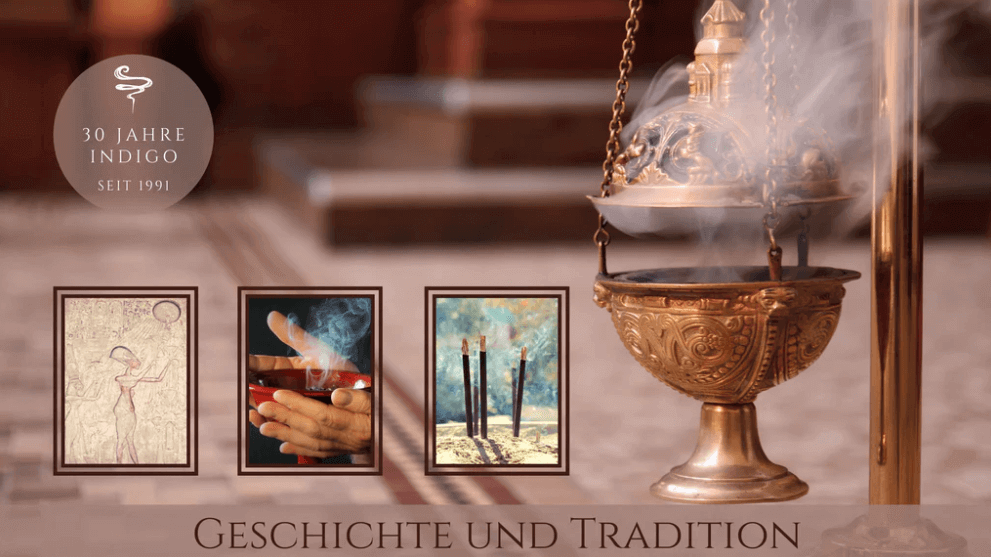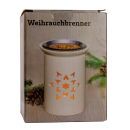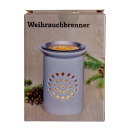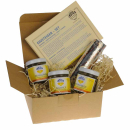Secrets of smoking: nature & harmony
Incense - power from nature
Noble scents elevate your senses, they open gates to higher consciousness and give you new possibilities on your path. Inside and outside.
The concept of incense and its role in different cultures offers a fascinating perspective on the use of natural scents and their influence on consciousness and well-being. Incense, which has been valued in various cultures for centuries, is not only used to perfume rooms and people, but also for spiritual and ritual purposes. The use of incense as a means of raising awareness and opening new possibilities on personal paths reflects the deep connection between humans and nature.
In many cultures, incense is used in religious and spiritual rituals to create a sacred atmosphere, aid meditation, or as part of healing rituals. The use of natural substances such as resins, herbs and woods in incense sticks or as loose incense mixtures shows appreciation for the gifts of nature and their transformative power.
This connection between natural scents, culture and spirituality can also be rediscovered and applied in a modern context. By using incense to create a calming and inspiring environment, one can tap into ancient wisdom and practices to increase one's well-being and awareness. This shows how traditional knowledge and practices can still be relevant and valuable in today's world.


1. Practice of smoking
The practice of smoking, found in diverse cultures and traditions worldwide, reflects the universal importance of scents and smoke in spiritual and ritual contexts. Each culture has its own specific smoking traditions that are deeply rooted in their cultural heritage and are often associated with important ceremonies and celebrations.
In India, for example, incense sticks are offered in large numbers in front of temples and shrines, which represents both homage to the deities and a cleansing and blessing of the space. This practice is an integral part of religious ceremonies and contributes to the spiritual atmosphere.
Sage bundles and braids of sweetgrass are used in North American Indian sweat lodge ceremonies. These elements not only serve for cleansing and healing, but also symbolize the connection to the earth and its spirits. Sage and sweetgrass have both physical and spiritual cleansing properties.
In South America, copal resin is used in initiation rites, indicating the importance of this resin in rites of passage. Copal, known for its strong, clear scent, is often used in rites of purification and protection.
The ancient Egyptians developed particularly complex incense recipes that were produced in the pharaohs' scent workshops. These recipes were known not only for their pleasant scents, but also for their ability to create and preserve sacred spaces.
Myrrh, which was used to purify and disinfect water in desert regions, shows how incense can serve practical and spiritual functions simultaneously.
Finally, frankincense and myrrh are also used in Christian services, especially at Christmas and during the Raunächte to clean and protect the house and yard. These traditions underscore the importance of incense in Christian liturgy and popular belief.
The diversity of these practices shows how incense emphasizes the togetherness and individual expression of people in shared celebrations. It connects people with their environment, their history and their belief systems and is a fascinating aspect of humanity's cultural heritage.
2. Smoking ritual & ceremony
Smoking as a ritual and ceremony is a powerful and symbolic practice that has been practiced in many cultures around the world for thousands of years. This tradition is not only an integral part of festivals and ceremonies, but is also used in everyday life. Smoking keeps alive ancient wisdom and customs that are deeply rooted in the history and traditions of the peoples.
The connection of incense burning with spirituality, rituals and celebrations shows how deeply this practice is anchored in human experiences and belief systems. Incense ceremonies often serve as a means of communicating with the divine, for purification, protection, or as part of healing processes. They are an expression of respect for nature and its forces as well as recognition of the connection between the human and the transcendent.
Many of the traditional ceremonies that involve incense reflect stylized forms of natural processes, everyday actions or special character traits of people and animals. These symbolic actions and the use of specific scents help to understand and internalize the deeper meanings and teachings contained in these ceremonies.
Smoking in rituals and ceremonies is therefore more than just the act of burning aromatic substances. It is a profound and layered experience that engages the senses, expands consciousness and bridges the physical and the metaphysical. It allows people to honor their traditions, deepen their spirituality and experience a sense of connection to the world and the cosmos.
3. Why do we smoke?
Smoking offers a unique opportunity to incorporate nature into our daily lives and thereby positively influence various aspects of our well-being and our environment. This practice, which is much more than just burning scented substances, can be used in a variety of ways:
Energetic cleaning and harmonization: Smoking is often used to energetically cleanse rooms and create a harmonious atmosphere. This can be particularly helpful in clearing negative energies and promoting a sense of peace and calm.
Natural power reserve: The scents released during smoking can serve as a type of natural power reserve. They can help invigorate the senses, increase concentration and increase overall energy levels.
Source of aesthetics and a refined lifestyle: Smoking can also be considered as an aesthetic element that adds a touch of elegance and a refined lifestyle. Selecting and burning quality incense can be an art form that reflects the beauty and depth of traditions and cultures.
The scent of fine incense also has the potential to promote personal well-being. Many people report that smudging helps them feel more aware and connected to their inner self. It can open a door to deeper self-awareness and conscious being.
In the modern world, where we are often surrounded by artificial and synthetic products, smudging offers a way to return to nature and experience its gifts in a direct, sensual way. By demystifying the world of incense and rediscovering incense as a natural source of energy, we can create a deeper connection with our environment and ourselves. It is up to us to incorporate this ancient art into our daily lives and reap its numerous benefits.
3.1 Making incense for your 7th sense
INDIGO ENTERPRISES, a Vienna-based company, has stood for the handcrafted production of high-quality incense since 1991. Our smoking products are manufactured according to traditional and mostly our own, carefully developed recipes. We pay particular attention to the craftsmanship of our products, which are created in a process that is deeply rooted in the handcraft tradition.
A key feature of our production method is the consideration of astrological and natural time and elemental vibrations. We believe that these influences make a decisive contribution to the quality and effectiveness of our incense. Therefore, we align our production process with these procedures to ensure that every incense is created in harmony with these cosmic and natural forces.
In addition, we attach great importance to the quality of the raw materials used. We carefully select our ingredients to ensure they meet our high standards of purity and potency. This combination of traditional craftsmanship, astrological knowledge and high-quality raw materials makes every product from INDIGO ENTERPRISES a unique and valuable element for smoking ceremonies and everyday well-being.
Through a dedication to quality and tradition, we at INDIGO ENTERPRISES create incenses that not only smell, but also bring a deeper level of well-being and harmony to the spaces in which they are used.
3.2 Manufacturing basis
The effectiveness of the mixtures always corresponds to the current zeitgeist. Although they sometimes vary slightly in their appearance or scent nuances, this is precisely how we can guarantee consistently high and energetic effectiveness - with purely natural products adjustments must be made from time to time. Our mixtures contain pure natural herbs, flowers, roots and bark, mostly from controlled organic cultivation (kbA), precious resins from wild collection, as well as the purest essential oils and herbal essences. You can find information about the ingredients in the online shop for the individual glasses, as well as on the glasses themselves. The bottling in hexagonal glasses was deliberately chosen. They are a symbol of the hexagonal shape of the cell, the original form of life. Our work is based on the wisdom of our ancestors and observing and learning from nature.
Our basic approach to production is:
“Work is love made visible”
3.3 Effects of incense - smelling means remembering
The plant world with its diverse powers is a natural source of energy for us humans. We naturally eat fruit, vegetables and herbs for more strength and vitality. We drink teas and use medicinal herbs to promote our health and the colors and shapes of the plants in nature and in our home affect our feelings. But our spirit and our intellect are also strong and are subject to negative and positive influences. More than ever before, we must pay attention to a harmonious balance between body, emotions and mind through a balanced natural energy supply.
Through smoking, the active ingredients of herbs, resins and woods are made available to humans in a comprehensive way, because even Western, intellectual people can understand, sniff, feel and understand the effects of incense.
The effect of incense is easy to understand based on the development of the sense of smell. The sense of smell is a primal instinct and is one of the oldest forms of our perception. Scents that we take in through our nose have a direct effect on the oldest part of our brain, the brain stem, where our instincts and experiences are stored, and on the limbic system, where our emotional perception takes place.
To smell something is to "remember" because natural scents trigger memories of images, feelings, experiences and moods in life. We can use this to re-tune ourselves, get in the mood and feel good. We are in contact with our inner perception, with the famous “inner voice”. The mind comes second. By smelling we can bypass mental patterns and impressions, habits and attitudes and even influence them.
Be careful with synthetic fragrances. They can only reproduce part of an image or feeling in us and are rather confusing for our perception. We can handle a variety of natural scents, because even a walk in nature, with countless scent impressions, has a harmonizing and relaxing effect on us. When smoking, you should therefore make sure to only use purely herbal incense. We at INDIGO ENTERPRISES guarantee this with all of our products.
3.4 Incense application
The method of application we recommend is SMOKING ON CHARCOAL. We have been testing and using them for more than 30 years and find them to be the most suitable and versatile way of smoking. In addition to practical tips for the correct smoking on charcoal, you will find information here on the use of incense, smoking charcoal, smoking tongs, incense burner, smoking sand, incense feather, incense spoon, incense broom and the correct dosage for people and in rooms.
3.5 Basic equipment and 1st steps of smoking
Smoking is a practice that has both a spiritual dimension and a practical use. To start smoking, you need basic equipment that will make the experience pleasant and safe. Here are the first steps and the necessary supplies:
Incense burner: A fireproof vessel serves as the basis for the incense ritual. It should be filled with a layer of shell sand to insulate the heat.
Charcoal and charcoal tongs: High-quality charcoal is essential. Tongs make it easier to hold and light the coal safely.
Ignition materials: A lighter or matches are necessary to ignite the coal.
Incense: Use purely herbal and effective incense, for example from INDIGO ENTERPRISES®, to create a harmonious atmosphere.
Incense spoon: A small metal spoon helps with dosing and applying the incense to the coals.
Incense feather and incense broom: A feather is used to fan the coals and distribute the scent. A smoking broom is used to clean the sand and the vessel.
Time, positive attitude and mindfulness: Smoking requires calm and a conscious attitude, both towards the process and towards the environment.
4. Carrying out the smoking ritual
Lighting coal: Hold the coal with tongs and gently light it over a flame until it begins to sputter. Then place the coal on the sand in the incense burner and let it glow for about 15 minutes.
Placing incense: When the coal is covered by a layer of white ash, place 1-2 pinches of incense with the spoon.
Enjoy the scent: Breathe in the scent like the smell of a flower. You can also walk around the room with the incense burner and diffuse the scent with the feather.
Removing incense residue: As soon as the incense has lost its scent, remove the residue with the spoon and steam it in the sand.
Cleaning and reuse: After the coal has burned out and the vessel has cooled, clean the vessel with the incense whisk. The sand can be reused.
The duration of the scent experience depends on the dosage and composition of the incense. A 3 cm diameter coal glows for about an hour. During this time you can add more incense depending on your needs and desired atmosphere. Take your time to enjoy the scent and effect and decide based on your feeling when the right mood has been reached.
4.1 Charcoal - In the beginning there was fire
Incense charcoal, a central component in the practice of smoking, symbolizes the element of fire and stands for impulse, new beginnings and transformation. This charcoal is made from fine beechwood charcoal dust that is pressed into tablets with a small amount of natural saltpeter salt. It provides an efficient, natural and easy-to-use heat source for smoking both indoors and outdoors.
The size of the incense coal determines its burning time: a coal with a diameter of 3 cm burns for around an hour, while a larger, 4 cm coal burns for around an hour and a half. High-quality charcoal, such as the recommended brand "Three Kings", minimizes unwanted odors. It only develops a slight smell when it is lit.
Some criticisms of smoking charcoal, such as unpleasant odors, health concerns or fine dust pollution, are often due to inferior charcoal quality, improper handling or a lack of experience. When used correctly and selecting high quality products, charcoal is a practical, environmentally friendly and efficient method of heating herbal incense.
Charcoal is therefore more than just a source of heat; it is an essential part of the incense ritual, which symbolizes the power of fire and stands for transformation and renewal. It reminds us that at the beginning of all incense ceremonies is the elemental fire.
4.2 Incense tongs
The smoking tongs are an essential tool for every smoking lover, essential for the safe and clean handling of smoking charcoal. It can be made of bamboo, although metal models are also a good alternative. Their main function is to hold the charcoal safely when lighting and to help prevent finger burns or contamination.
It is important to ensure that the bamboo tongs are not placed near the glowing coals to prevent the material from charring. This is especially true if bamboo is chosen as the material, as it is more flammable than metal.
The smoking tongs are more than just a functional tool; It combines aesthetics with practicality and is therefore an indispensable utensil for anyone who smokes regularly. Their use highlights the care and mindfulness given to the practice of smudging, making the smudging ritual a safe and enjoyable experience.
4.3 Smoking sand
Smoking sand plays an important role in the practice of smoking by acting as a heat buffer in the censer. This prevents the vessel from becoming too hot and at the same time allows an adequate supply of air to the charcoal. The sand also protects the vessel from resins sticking to it. After extensive testing, we decided to use heat-cleaned shell sand, which is ideal for several reasons:
Optimal grain size: Shell sand has a coarser grain size than mineral sand and therefore offers just the right amount of air circulation so that the charcoal burns effectively but not too quickly.
Heat Regulation: Unlike mineral sand, which reflects heat and excessively heats the vessel, shell sand absorbs heat and distributes it evenly. This ensures that the vessel becomes warm but not hot, preventing incense from burning.
Hygienic and odor-free quality: Shell sand is cleaned and sterilized by heat, making it environmentally friendly and odorless when it comes into contact with the hot coal.
Easy to clean and reuse: Due to its coarser grain size, the finer ash falls through, while incense remains remain on the surface. After the coal has cooled, these residues can be easily removed with a smoking whisk, allowing the sand to be reused frequently (10-20 smoking sessions).
Some customers prefer personally meaningful sand from streams, rivers or vacation trips. Although this may have a special meaning, it is important that it is well dried. However, mineral sand can prevent the coal from burning completely. A mixture with shell sand can help here and ensure a pleasant smoking experience.
Be careful when buying smoking sand. Not all sand that is sold as “smoking sand” is suitable for this. We recommend asking specifically for heat-cleaned shell sand, which is also available at most Indigo Enterprises and Duftklang retail partners. Colored or scented decorative sand should not be used as it does not have the properties required for smoking.
In elemental science, smoking sand symbolizes the element of water, which stands for feeling, intuition and bringing things into flow, and thus complements the smoking ceremony in a very special way.
4.4 Incense spoon
The smoking spoon is a practical tool that fulfills the following functions:
Handling the incense: Makes it easier to stir and remove the incense from the container.
Dosage: Allows precise placement of the incense on the coals.
Removal of incense residue: After the fragrances have been used up, residue can easily be removed from the charcoal.
Made from metals such as copper or iron, the incense spoon has a small scoop that allows optimal dosage of the incense. We offer three different models that are tailored to different smoking needs.
Witch's spoon made of iron: This spoon is a true all-rounder. Made of robust iron, it is ideal for sticky incense. Its special feature lies in the small smoking whisk at the end of the spoon, which gives it its name. This addition makes the witch's spoon particularly practical if you don't have a large smoking broom at hand. Its stability and reliability make it an indispensable tool for all smoking enthusiasts.
Copper Spoon: The copper spoon is a classic tool in the world of smoking. Copper, known for its Venusian properties, promotes cognition and is traditionally preferred for dealing with energy-rich plants. However, copper is a soft metal, so this spoon can bend more easily when handling sticky resins and mixtures.
Spiral iron spoon: A special creation from Duftklang. This spoon is characterized by its spiral design, which symbolizes the original form of development and flowing energy. Inspired by the Celtic one-handed rod that Druids used to measure earth rays and water veins, this spoon is not only practical but also an aesthetic masterpiece. The spiral not only serves as a place for the charcoal to be lit, but is also ideal for removing coarse incense residue. Its robustness and versatility make it an essential tool for any smoking ceremony.
4.5 Incense burners
Incense burners are available in a variety of shapes and materials, but there are certain criteria they should meet to be used effectively and safely in incense practice:
Non-flammable material: Materials such as stoneware, ceramic or metal are ideal as they can withstand heat and are non-flammable.
Sufficient size: A minimum diameter of 12 cm is recommended. Smaller vessels, especially those made of metal, can quickly become too hot and pose a risk.
Aesthetics and functionality: The incense burner should not only be visually appealing, but also practical for the intended areas of use.
Based on these criteria, we have developed our own smoking bowl models. They are made of high quality stoneware that is fired up to three times at around 1200°C to ensure high heat resistance. Our containers offer an optimal size and depth to make it easy to reach the coal without the sand falling out as you walk through the house.
Two special models are the incense goblet and the flat incense goblet. The incense goblet is ideal for hand-holding, while the flat incense goblet is good for use on the floor, tables or when working with children. The smoking cup, a larger model, is intended as a decorative element for special rooms.
We have also been offering colored glazed indigo hanging bowls since 2010. These bowls are equipped with leather straps and are particularly suitable for fumigating large rooms or for permanent hanging.
In elemental science, the incense burner represents the element earth. It symbolizes body, matter, grounding, protection, health and stability, which underlines its central role in the smudging ceremony.
4.6 Incense broom
The smoking whisk is an essential tool for anyone practicing the art of smoking. It is used to effectively remove ash and incense residue from the incense sand as soon as the embers and sand in the incense burner have cooled down. Additionally, it is extremely helpful in keeping the area around the incense table clean, especially between the various jars of incense. This way you can keep things tidy without having to constantly put everything away. An essential utensil for all smoking enthusiasts - both women and men who are dedicated to the art of smoking. However, caution is advised: the smoking whisk should not come into contact with open flames or glowing coals to avoid damage. Therefore, always keep it away from heat sources!
4.7 Incense feather
The incense feather is a symbolic and spiritual tool in the art of incense. Similar to a magic wand in the hands of a shaman, priest or medical practitioner, the incense feather contributes to a deeper inner attitude. Traditionally, bird of prey feathers were used because each species of bird has a specific symbolic meaning. For example, the eagle represents leadership, spirituality and foresight, the falcon speed and communication, while the owl symbolizes wisdom, the mysterious and introspection.
Due to legal regulations in Austria, we limit our range to the following types of springs:
Turkey Feathers: These represent a sense of community and family, friendship, grounding, fertility, stability and manifestation.
Goose feathers: They symbolize departure, helpfulness, loyalty, stability and protection, as well as the ability to take turns taking over leadership.
Incense feather also serves as a reminder of important principles of the element of air in the practice of incense:
Appreciation of time: Smoking incense is an act of appreciation for yourself and others.
Positive attitude: smoking should always be done “for” something and never “against” something.
Respect for space: Permission should always be asked when smoking for others.
In elemental science, the incense feather corresponds to the element air, which stands for intellect, clarity of spirit and a positive orientation.
5. Dosage of incense
The dosage of incense is an essential aspect of experiencing the full effect of the scents while creating a pleasant atmosphere. Here are some instructions and tips on proper dosage:
For use on coal:
Place 1-2 pinches of incense on the white-hot coals. To allow all fragrances to be released, do not overload the charcoal.
Enjoy the scent by smelling it or diffusing it around the room as long as it creates a pleasant smell.
As soon as the scent becomes sizzling, remove the incense residue from the coals with a spoon and steam it out in the sand.
If necessary, add the same or a different incense until the desired atmosphere is achieved.
Dosage for humans:
As a rule, 1-2 pinches of an indigo incense scent are enough to make a person smell pleasant.
Depending on your mood on the day, several smoking sessions may be necessary to achieve the desired effect.
The first reaction to the scent occurs immediately, but the entire body only reacts after about 2-3 minutes. Take time to feel the effects on body and mind and share your perceptions.
Dosage in rooms:
Here too, 1-2 pinches of incense are placed on the coals.
Walk around the room with the incense burner while the scent is pleasant.
Remove any smelly residue and add more incense as needed.
Repeat the process until the scent can be felt throughout the room. Ventilate the room as necessary.
6. Indigo method for fumigation of rooms
Cleaning: Carry out a first pass and then ventilate thoroughly.
Harmonization: Carry out this step without ventilation unless the smoke is too strong.
Energy Building: Finish with this step to strengthen the positive energy in the room.
In all of these steps, it is important to follow your feelings and be guided by the reaction of your body and your environment. As long as the scent is pleasant to you, there is no risk of overdosing. Ventilate the room occasionally to maintain a fresh atmosphere.
7. The rough nights
The Smoking Nights, also known as “Raunächte”, are a traditional time of smoking that is closely linked to old customs and traditions. These nights typically take place during the transition from the old year to the new year, with different cultures having designated different periods for this practice. The most common dates for the smoking nights are:
The Twelve Nights: These cover the period from December 24th (Christmas Eve) to January 6th (Epiphany). During this time there are twelve nights, each of which is said to correspond to a month of the coming year. Smoking on these nights serves to cleanse, protect and prepare for the New Year.
The Winter Solstice: Some traditions place the beginning of the Incense Nights on the winter solstice on December 21st or 22nd. The solstice marks the shortest day and longest night of the year, a significant event in the natural calendar that is often celebrated with smudging ceremonies.
Thomas Night: In some regions, Thomas Night on December 21st is also seen as the beginning of the Incense Nights.
These times are used to cleanse the house by smoking with special herbs and resins, to drive away evil spirits and to ask for blessings and protection for the coming year. The tradition of smoking nights is deeply rooted in European folklore, especially in the Alpine regions.






























